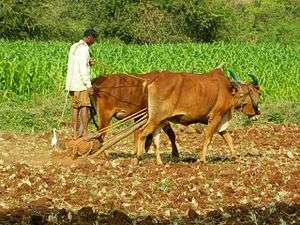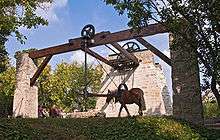Working animal
A working animal is an animal, usually domesticated, that is kept by humans and trained to perform tasks. They may be close members of the family, such as guide dogs or other assistance dogs, or they may be animals trained to provide tractive force, such as draft horses or logging elephants. The latter types of animals are called draft animals (draught animals) or beasts of burden. Most working animals are either service animals or draft animals. They may also be used for milking or herding, jobs that require human training to encourage the animal to cooperate. Some, at the end of their working lives, may also be used for meat or other products such as leather.
The history of working animals may predate agriculture, with dogs used by our hunter-gatherer ancestors. Around the world, millions of animals work in relationship with their owners. Domesticated species are often bred to be suitable for different uses and conditions, especially horses and working dogs. Working animals are usually raised on farms, though some are still captured from the wild, such as dolphins and some Asian elephants.

People have found uses for a wide variety of abilities found in animals and even in industrialized society many animals are still used for work. The strength of horses, elephants and oxen is used in pulling carts and logs. The keen sense of smell of dogs is used to search for drugs and explosives as well helping to find game while hunting and to search for missing or trapped people. Several animals including camels, donkeys, horses and dogs are used for transport, either riding or to pull wagons and sleds. Other animals including dogs and monkeys provide assistance to blind or disabled people.
On rare occasions, wild animals may be not only tamed, but trained to perform work, though often solely for novelty or entertainment purposes, as such animals tend to lack the traits of trustworthiness and mild temper that characterize the true domesticated working animal. Conversely, not all domesticated animals are working animals. For example, while cats may perform work catching mice, it is an instinctive behavior, not one that can be trained by human intervention. Other domesticated animals, such as sheep, or rabbits, may have agricultural uses for meat, hides and wool, but are not suitable for work. Finally, small domestic pets such as most birds (other than certain types of pigeon) or hamsters are generally incapable of performing work other than that of providing simple companionship.
Roles and specializations
Transportation
Some animals are used due to sheer physical strength in tasks such as ploughing or logging. Such animals are grouped as a draught or draft animal. Others may be used as pack animals, for animal-powered transport, the movement of people and goods. People ride some animals directly as mounts; Alternatively, one or more animals in harness may be used to pull vehicles.
Riding animals or mounts
They include equines such as horses, ponies, donkeys, and mules; elephants; yaks; and camels. Dromedary camels in arid areas of Australia, North Africa and the Middle East; the less common Bactrian camel inhabits central and East Asia; both are used as working animals. On occasion, reindeer, though usually driven, may be ridden.
Certain wild animals have been tamed and used for riding, usually for novelty purposes, including the zebra and the ostrich. Some mythical creatures are believed to act as divine mounts, such as garuda in Hinduism and the winged horse Pegasus in Greek mythology.
Pack animals

Pack animals may be of the same species as mounts or harness animals, though animals such as horses, mules, donkeys, reindeer and both types of camel may have individual bloodlines or breeds that have been selectively bred for packing. Additional species are only used to carry loads, including llamas in the Andes.
Domesticated oxen, bullocks, and yaks are also used as pack animals. Other species used to carry cargo include dogs and pack goats.
Harness animals
An intermediate use is to harness animals, singly or in teams, to pull (or haul) sleds, wheeled vehicles or plough.
- Oxen are slow but strong, and have been used in a yoke since ancient times: the earliest surviving vehicle, Puabi's Sumerian sledge, was ox-drawn; an acre was originally defined as the area a span of oxen could plow in a day. The Water buffalo and Carabao, domesticated water buffalo, pull wagons and ploughs in Southeast Asia and the Philippines.
- Draught or Draft horses are commonly used in harness for heavy work. Several breeds of medium-weight horses are used to pull lighter wheeled carts, carriages and buggies when a certain amount of speed or style is desirable.
- Mules are considered to be very tough and strong, with harness capacity dependent on the type of horse mare used to produce the mule foal. Because they are a hybrid animal and usually are infertile, separate breeding programs must also be maintained.
- Ponies and donkeys are often used to pull carts and small wagons, historically, ponies were commonly used in mining to pull ore carts.
- Dogs are used for pulling light carts or, particularly, sleds. (e.g. sled dogs such as Huskies) for both recreation and working purposes.
- Goats also can perform light harness work in front of carts
- Reindeer are used in the Arctic and sub-Arctic Nordic countries and Siberia. During World War II the Red Army deployed deer transportation battalions on the Eastern Front.[1] In the twenty-first century, Russian soldiers continue to train with reindeer sleds in winter.[2]
- Elephants are still used for logging in South-east Asia.
- Less often, camels and llamas have been trained to harness. According to Juan Ignacio Molina the Dutch captain Joris van Spilbergen observed the use of chiliquenes (a llama type) by native Mapuches of Mocha Island as plough animals in 1614.[3]
Assorted wild animals have, on occasion, been tamed and trained to harness, including zebras and even moose.
Searching and retrieving
Hunting

As predatory species are naturally equipped to catch prey, this is a further use for animals and birds. This can be done either for sustenance, sport, or to reduce the population of undesired animals that are considered harmful to crops, livestock or the environment.
- Hounds and other dogs are used to kill and fetch prey. Certain breeds have been bred for this task such as pointers and setters.
- Mousers (domestic cats used for hunting small rodents and birds) are one of the oldest working animals having protected food supplies from pests since the foundation of human agriculture.
- Caracals are sometimes used as hunting animals in some parts of the Middle East, although they are normally kept as pets.
- Cheetahs that have been tamed but not domesticated have been used by humans for chasing down prey.
- Ferrets prey on creatures living in burrows, such as rabbits.
- In falconry, birds of prey are used as hunters in the air.
- Aquatic birds, such as cormorants in China, can be used to catch fish.
Humans
- Dogs, with their highly developed sense of smell, are used to locate humans, such as escaped prisoners or people lost in remote areas. They are used also to find people who are trapped, such as in avalanches or collapsed buildings.
- Horses are used in remote areas to help human searchers cover large areas of rugged terrain. Their natural awareness of their surroundings will often alert human handlers to the presence of anything unusual, including lost hikers, hunters or other. Like some dogs, some horses are trained to follow scent. See Search and rescue horse.
Sniffing Animals
- Dogs and pigs, with better smell sense than humans, can assist with gathering by finding valuable products, such as truffles (a very expensive subterranean mushroom). In France mainly pigs are used, in Italy mainly dogs. See Truffle hog.
Interfacing and organization
Assistance animals
- The best-known example is the guide dog or seeing eye dog for blind people. See also service dog. Miniature horses are also occasionally used for this purpose as well.
- Trained African monkeys and dogs have been taught to provide other functions for impaired people, such as opening mail and minor household tasks of the same like.
Herding

- A very close working relationship exists between a stockman or shepherd, a herding dog, and the herd (or mob) of sheep or cattle. Cattle and sheep herders in other parts of the world also use various dog breeds. See Mountain dogs.
- Certain breeds of horses also have an innate "cow sense" that allows them to effectively carry a rider to the right place at the right time to muster (gather or round up) livestock. See stock horse; cutting horse
Employers
Military animals
The defensive and offensive capabilities of animals (such as fangs and claws) can be used to protect or to attack humans.
- The guard dog barks or attacks, to warn of an intruder
- War elephants were trained for battle in ancient times and are still used for military transport today.
- Military uses of horses have changed over the millennia but still continue, including for police work.
- Dolphins and sea lions carry markers to attach to mines as well as patrolling harbors.
- On land, dogs can be trained to find landmines. Rats, which are lighter and less of a risk to set the mines off, have recently been used more frequently.[4] Detection rats such as those trained by APOPO can also be taught to identify diseases, especially pulmonary tuberculosis.[5]
- Homing pigeons transport material, usually messages on small pieces of paper, by air.
Legal status
In some jurisdictions, certain working animals are afforded greater legal rights than other animals. One such common example is police dogs, which are often afforded additional protections and the same memorial services as human officers.
See also
| Wikimedia Commons has media related to Working animals. |
References
- ↑ Андрей Зайцев (8 May 2013). Оленьи батальоны на Мурманском рубеже (in Russian). Мурман. Retrieved 5 August 2014.
- ↑ "Russian soldiers train in sub-zero temperatures with reindeer". BBC. 4 February 2016. Retrieved 4 February 2016.
- ↑ The Geographical, Natural and Civil History of Chili, Pages 15 and 16, Volume II
- ↑ Bees, Giant African Rats Used to Sniff Landmines. In National Geographic, 10 February 2004. Webpage found 12 March 2010.
- ↑ APOPO, Dutch organization that raises and trains detection rats for worldwide use. See also HeroRAT.
- Falvey, John Lindsay (1985). Introduction to Working Animals. Melbourne, Australia: MPW Australia. ISBN 1-86252-992-2.
External links
- Working Goats Documentary produced by Oregon Field Guide

